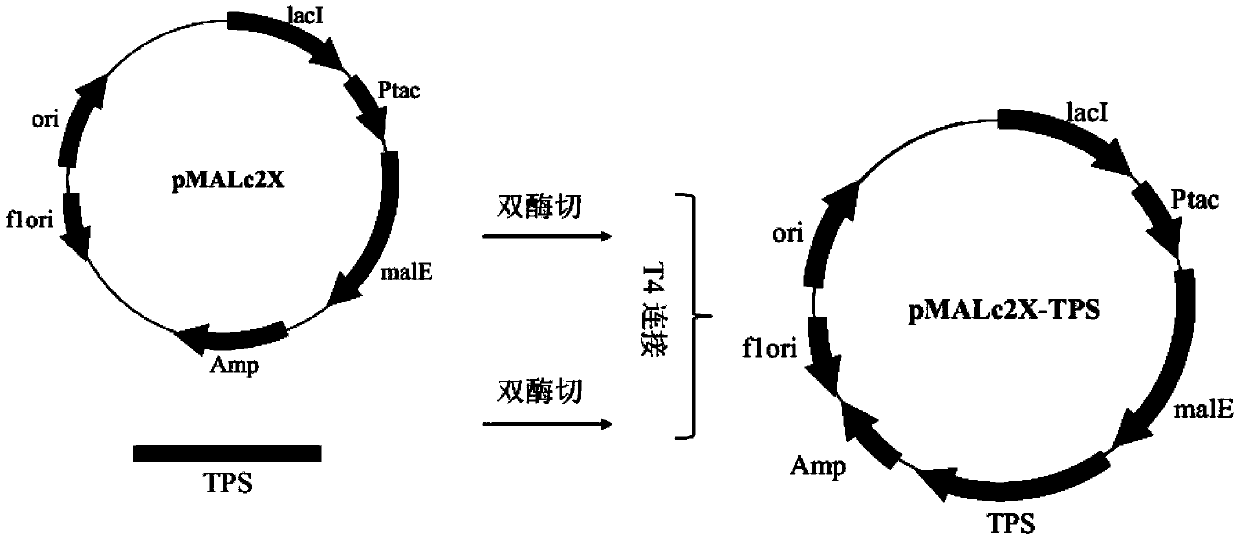Application of Tripterygium wilfordii twks and twcps3 in the preparation of kaurane-type diterpenoids
A kaurane-type, kaurane technology, applied in the field of 16α-kaurane, can solve the problems of restricted development, slow plant growth, low content, etc.
- Summary
- Abstract
- Description
- Claims
- Application Information
AI Technical Summary
Problems solved by technology
Method used
Image
Examples
Embodiment 1
[0031] Embodiment one, Tripterygium wilfordii Twcps3 and Twks prokaryotic expression vector construction ( figure 1 )
[0032] Using the vector pMD-19-TPS plasmid containing the full-length cDNA of Tripterygium wilfordii Twcps3 and Twks genes as templates, PCR amplification of the gene coding region was carried out with primers containing restriction sites (see Table 1 for the primer sequences), and inserted into the prokaryotic expression vector middle. The DNA polymerase uses high-fidelity DNA polymerase (PrimeSTAR HS DNA Polymerase). The PCR parameters were 98°C for 3min, 1 cycle; 98°C for 10s, 60°C for 10s, 72°C for 2min30s, 30 cycles; 72°C for 7min; 4°C for maintenance. The amplified product was recovered by Gene JETGel Extraction Kit gel (method as follows).
[0033] Gene JET Gel Extraction Kit gel recovery steps:
[0034] (1) Take the PCR product and pre-mix it with 6×loading buffer, and electrophoresis on 1.5% agarose gel with low voltage (about 5Vcm-1) for 30-60mi...
Embodiment 2
[0055] Example 2. Induced Expression of Recombinant Proteins
[0056] induced expression
[0057] 100mmol·L-1IPTG: Weigh 238.3mg of IPTG, dissolve in 10mL of ddH2O, filter and store at -20°C; LB medium: Trytone 1.0%, Yeast Extract 0.5%, NaCl 1.0%, Agar1.5%, pH 7.0.
[0058] Steps:
[0059] (1) Take 1 μL of the recombinant plasmid containing the target gene that has been correctly identified by enzyme digestion and has been verified by sequencing, and transform it into 50 μl TransB (DE3) competent cells, smear LB+Amp (ampicillin sodium) solid plate, and incubate at 37°C 12-16h;
[0060] (2) Pick out monoclonal colonies and transfer them to 2mL LB liquid medium containing 100μg·mL-1Amp after enzyme digestion and identification, and shake culture at 37°C until OD600 reaches 0.6-1.0;
[0061] (3) Take 1 mL of bacterial liquid at 5000 g and centrifuge at 4°C for 5 minutes to collect the bacterial cells, suspend the bacterial cells with fresh LB+Amp liquid medium, and transfer t...
Embodiment 3
[0068] Embodiment three, sodium dodecyl sulfate-polyacrylamide gel electrophoresis (SDS-PAGE) ( figure 2 )
[0069] Reagent preparation
[0070] 30% acrylamide stock solution (neurotoxicity, wear a mask and gloves during operation): In a fume hood, weigh 29.2g of acrylamide and 0.8g of methylenebisacrylamide, add ddH2O to dissolve, and dilute to 100mL. After filtering with a syringe filter, put it in a brown bottle and store it at 4°C;
[0071] pH 8.8 Tris-HCl separating gel buffer: prepare 1.5M Tris-HCl, adjust the pH to 8.8, and store at 4°C;
[0072] pH 6.8 Tris-HCl stacking gel buffer: prepare 1M Tris-HCl, adjust the pH to 6.8, and store at 4°C;
[0073] 10% SDS: Weigh 1.0g of SDS, dissolve in 10mL of distilled water, store at 4°C;
[0074] 10% ammonium persulfate (APS): Take 1.0g of APS, dissolve in 10mL of distilled water, and store at 4°C;
[0075] TEMED (tetraethylethylenediamine) stock solution;
[0076]5×sample buffer (10mL): 0.6mL 1mol L-1 Tris-HCl (pH 6.8), ...
PUM
 Login to View More
Login to View More Abstract
Description
Claims
Application Information
 Login to View More
Login to View More - R&D
- Intellectual Property
- Life Sciences
- Materials
- Tech Scout
- Unparalleled Data Quality
- Higher Quality Content
- 60% Fewer Hallucinations
Browse by: Latest US Patents, China's latest patents, Technical Efficacy Thesaurus, Application Domain, Technology Topic, Popular Technical Reports.
© 2025 PatSnap. All rights reserved.Legal|Privacy policy|Modern Slavery Act Transparency Statement|Sitemap|About US| Contact US: help@patsnap.com



